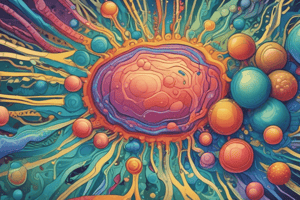Podcast
Questions and Answers
What is the primary function of cholesterol in the cell membrane?
What is the primary function of cholesterol in the cell membrane?
- To regulate the transport of substances into and out of the cell
- To recognize and interact with its surroundings
- To form a bilayer with phospholipids
- To maintain fluidity of the membrane at different temperatures (correct)
Which type of protein is found on the periphery of the cell membrane?
Which type of protein is found on the periphery of the cell membrane?
- Peripheral proteins (correct)
- Integral proteins
- Transport proteins
- Channel proteins
What is the function of the glycocalyx on the exterior of the cell membrane?
What is the function of the glycocalyx on the exterior of the cell membrane?
- To protect the cell and its organelles
- To help the cell recognize its surroundings and interact with other cells and molecules (correct)
- To regulate the transport of substances into and out of the cell
- To maintain the fluidity of the membrane at different temperatures
What is the percentage of phospholipids in the cell membrane?
What is the percentage of phospholipids in the cell membrane?
What is the function of the cell membrane in organ transplants and blood transfusions?
What is the function of the cell membrane in organ transplants and blood transfusions?
What is the primary function of the channel proteins in the cell membrane?
What is the primary function of the channel proteins in the cell membrane?
Study Notes
History of the Cell Membrane
- Garde Nicholson and Jonathan Singer proposed the fluid mosaic model in 1932
Composition of the Cell Membrane
- Phospholipids (40%): found throughout the cell membrane
- Proteins (50%): embedded in the phospholipid bilayer, can be found in the peripheral or interior of the membrane
- Carbohydrates (10%): found only on the exterior of the cell membrane
- Cholesterol: attached to phospholipids
Functions of Each Biomolecule
- Phospholipids:
- Have a polar, hydrophilic head and a non-polar, hydrophobic tail
- Form a bilayer with hydrophilic heads facing outward and inward, and hydrophobic tails facing inward
- Allow water to pass through, but not other substances
- Cholesterol:
- Helps maintain fluidity of the membrane at different temperatures
- Increases fluidity at low temperatures, decreases fluidity at high temperatures
- Proteins:
- Integral proteins: span the entire membrane
- Peripheral proteins: found on the periphery of the membrane
- Two types of integral proteins:
- Channel proteins: form a channel for molecules to pass through
- Transport proteins: change conformation to transport molecules across the membrane
- Carbohydrates:
- Form a glycocalyx (glycoproteins and glycolipids) on the exterior of the cell membrane
- Help the cell recognize its surroundings and interact with other cells and molecules
Functions of the Cell Membrane
- Protects the cell and its organelles
- Regulates transport of substances into and out of the cell
- Helps the cell recognize and interact with its surroundings
- Important for compatibility in organ transplants and blood transfusions
History of the Cell Membrane
- Garde Nicholson and Jonathan Singer proposed the fluid mosaic model in 1972 (not 1932)
Composition of the Cell Membrane
- Phospholipids make up 40% of the cell membrane and are found throughout
- Proteins account for 50% of the cell membrane and are embedded in the phospholipid bilayer
- Carbohydrates make up 10% of the cell membrane and are only found on the exterior
- Cholesterol is attached to phospholipids
Phospholipids
- Have a polar, hydrophilic head and a non-polar, hydrophobic tail
- Form a bilayer with hydrophilic heads facing outward and inward, and hydrophobic tails facing inward
- Allow water to pass through, but not other substances
Cholesterol
- Helps maintain fluidity of the membrane at different temperatures
- Increases fluidity at low temperatures, decreases fluidity at high temperatures
Proteins
- Integral proteins span the entire membrane
- Peripheral proteins are found on the periphery of the membrane
- There are two types of integral proteins:
- Channel proteins form a channel for molecules to pass through
- Transport proteins change conformation to transport molecules across the membrane
Carbohydrates
- Form a glycocalyx (glycoproteins and glycolipids) on the exterior of the cell membrane
- Help the cell recognize its surroundings and interact with other cells and molecules
Functions of the Cell Membrane
- Protects the cell and its organelles
- Regulates transport of substances into and out of the cell
- Helps the cell recognize and interact with its surroundings
- Important for compatibility in organ transplants and blood transfusions
Studying That Suits You
Use AI to generate personalized quizzes and flashcards to suit your learning preferences.
Description
Learn about the composition of the cell membrane, including phospholipids, proteins, carbohydrates, and cholesterol, and explore their functions in the cell.





